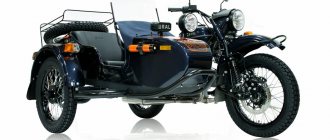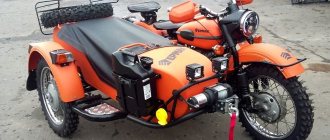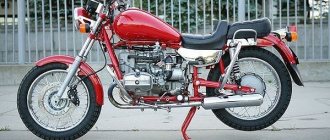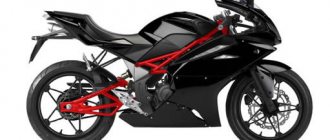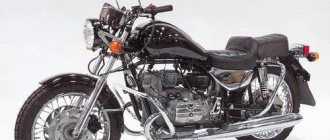Uraling - why are Ural motorcycles leaving for America?
Made in Russia sounds... rare. During the four years of my life in America, I came across only four Russian goods. Number one is, of course, Russian Standard vodka. Number two is the cartoon “Masha and the Bear” on Netflix, as well as toys based on it. And also a large package of Kamchatka crab and... a Ural motorcycle. Moreover, local fans even have rallies where they engage in - that's right, legalism.
National Ural Demo Day is a nationwide day of getting to know the Urals. No, this is not a new state program to attract foreign tourists to the Ural region of Russia, but an action of American dealers IMZ and the Irbit Motorcycle Plant, who are jointly organizing something like a mini-festival and open day. And the word “national” here is not an exaggeration: the website imz-ural.com lists nine official dealers in the USA, although in fact almost 50 showrooms sell Urals in America, while in Russia there are three official stores. And 15 times more motorcycles are sold here than in Russia: of the one and a half thousand units that the plant assembles per year, 95% are exported, and a little less than a thousand are sent to America. And if everything is approximately clear with vodka, Masha, the Bear and the crab, then the success of the Urals in the USA...
On the other hand, why be surprised if IMZ has been part of the IMZ-Ural Group company since 2007, which is registered in the USA and is located in Redmond, Washington, next to the headquarters of Microsoft and Amazon?
A brief background is as follows. In the late 90s, the Irbitsky plant, already privatized at that time, was acquired by businessman Kakha Bendukidze and included in his OMZ holding. Bendukidze then hired a team of managers and consultants to figure out what to do with the huge plant, but in 2000 IMZ went bankrupt anyway and eventually went to those same managers and consultants led by Ilya Khait, who remains the owner and general director of IMZ today. Ural Group. The new owners laid off almost the entire staff, leaving one and a half hundred employees from the once ten thousand team, became concerned about product quality, introduced many modern components and conquered America, something Lada and UAZ only dream of.
Or don't they dream? To figure it out, I decided to travel in the Urals. True, the nearest official dealer is a thousand kilometers from my home in Miami, but just two hundred miles from me, in the town of Holopo, there was a hangar of Gene Langford, one of the pioneers of legalization.
In the early 2000s, Gene visited Irbit (he is on the far right in the photo), then the American history of the Urals was just beginning
This dealer is not listed on the Ural website, but the brand is based on such enthusiasts. This is a club and a museum at the same time, where the showroom is combined with a spare parts warehouse and an exhibition of Soviet-era accessories, including clothes and badges. Who are the buyers? Gene says that you won’t find two identical clients in nature, just like the Urals themselves. Of course, these are mostly adventure lovers. Some people choose a motorcycle for its military background. There are nonconformists for whom it is important to stand out - “because it’s not Harley.”
The full version is available only to subscribersSubscribe now
I'm already subscribed
1915 Harley-Davidson with the first original Harley sidecar. A curious machine - a motorcycle with a sidecar. Few of us rode in a stroller or in the back seat, and even fewer of us drove. But there are a small number of wheelchair enthusiasts who love their three-wheeled vehicles, sometimes called a sidecar or sidecar, and a significant number of companies that try to supply their products to their true connoisseurs. The origins of the sidecar are a matter of debate, but with the advent of the roller chain patent in 1880 and the advent of the popularity of the "safety" bicycle (with two equal-sized wheels driven by a chain at the rear), creative minds developed a very lightweight sidecar so that energetic young cyclists could transport their I'll give it style. When motors began to be installed on bicycles, the idea of carrying a passenger arose. In the Victorian era, you couldn't see a self-respecting woman in the back seat, not to mention the old back seats were terribly uncomfortable. The first mention I found of a motorcycle with sidecar was an 1893 competition set up by a French newspaper that promised a reward to the person who could come up with the best way to carry a passenger in comfort and elegance. Three very different methods were presented: from the front, from the back on a trailer, and from the side in a stroller.
Classic English crew. 1953 Ariel square four with Watsonial Squire sidecar Carrying a passenger in the front was a reverse tricycle, with two wheels and a passenger seat in the front and the driver sitting in the back. Anyone who had the pleasure of being in Saigon in 1960 probably drove one of these things with a sociopathic Viet Cong swashbuckler behind the wheel. The main problem was that the passenger literally “took the blow” in any collision. Rear trailer idea. A raised tongue that extends over the rear wheel and is attached to the motorcycle frame, usually under the seat. This two-wheel trailer could provide quite a lot of space, but the passenger would get all the noise and exhaust fumes, which was not popular among graceful ladies. The third and final option is a sidecar. The very first photo of a motorcycle with a sidecar that I saw was a Thor motorcycle with a sidecar, which the American company included in its catalog. The stroller was very presentable, made of wicker twigs. Which is good because of the light weight.
Five years later, motorcycle manufacturers began offering factory sidecars, and not only cradles, but also cargo bodies for delivery vehicles. A motorcycle and sidecar were cheaper compared to cars, and on bad American roads, stuck in the mud, they were easier to get out.
BMW P75 1943 as an example of a military motorcycle with a sidecar from the Second World War
Sidecar frames were fairly simple, usually tubular steel, with a sidecar or cargo container attached by bolts. In 1913, sidecar designers chose 2, 3, or 4 attachment points for the sidecar to the motorcycle. Two-point fastenings quickly disappeared, probably due to the fact that most strollers fell off on their own at speed. Most strollers did not have suspensions, but leaf springs were starting to appear. In 1913, Earl Johnson of Harlan, Iowa, patented a carriage with a sidecar wheel that could tilt with the motorcycle, anticipating the Flexi-Flyer (sidecar wheel tilts when the cradle is level) and Equa-Lean (the wheel sits in the center of the tilting cradle) designs.
The stroller itself could be single- or double-seater, cargo-carrying, with fire-fighting equipment, or a chimney sweeper. Harley Davidson was ready to tap into the stroller gold market. Their first catalog stroller appeared in 1914 and was actually made by Rogers. In 1915, Harley Davidson began making his own strollers. In 1916, the US Army ordered several Harley sidecars to fight Pancho Villa's troops in the deserts along the Mexican border, and Bill Harley designed a machine gun mount for the sidecar. During World War I, many motorcycles with sidecars were supplied to the Western Front, but they were used more as messengers and for transporting officers than for attacking enemy positions with machine gun fire. After the war, cars became quite inexpensive and there were fewer and fewer strollers. Trade continued to flourish with such firms as the English Watsonian (sold strollers since 1912), the German Steib (started in 1914) and the Australian-American Jim Goodling. They were very active, albeit limited. The Great Depression helped the industry a little because the motorcycle and sidecar were the cheapest means of transportation.
The third wheel is useful on a wet dirt road, Daytona Champion 2+2 sidecar After the Second World War, the American consumer society craved huge cars, and not motorcycles with sidecars. In Europe, low taxation on two- and three-wheelers and low car ownership have seen another flurry of interest in sidecars. However, by the late 1950s, thanks to cheap cars such as the British Ford Popular and the German VW Beetle, small cars again defeated sidecars. The industry collapsed, realizing that from a practical point of view, the motorcycle with sidecar had become useless. The only factories producing them as utilitarian vehicles were in the eastern bloc, such as the Czechoslovak Velorex in collaboration with Java, Ural and Dnepr in the Soviet Union [the author either knows nothing about Izh motorcycles with sidecars from the Vyatka-Polyansky plant, or does not consider them for motorcycles at all] and the Chinese. And Harley, of course, but more for ceremonial use. But enthusiasts breathed life into the legend. Californian Doug Bingham, also known as Mr. Side Strider Inc., began building and selling sidecar motorcycles in 1969. He established an annual wheelchair rally in Griffin Park in Los Angeles for decades before his death in 2016. A half-dozen other American companies, such as Champion and Motorvation, as well as Texas and California (made in Virginia), make strollers, with a long list of options and related products.
No need to be afraid of falling on wet grass in the Urals with a sidecar. In Europe, there is a demand for specialized motorcycles with sidecars with complex suspension systems designed to improve handling, usually of a bulky design. I remember well the day when I was riding in the Alps and far ahead I saw a motorcycle with a sidecar. Just as I was thinking about catching up with him, he probably saw me in the rearview mirror and accelerated, and all I could do was hang on behind him. And only in heavy traffic was I able to catch up with him. It was a BMW K100 with a reclining stroller, with a wife and child in it. Now in this country there is only one company that sells motorcycles with sidecars: Russian Ural. And there are a dozen American companies that manufacture or import strollers, the purchase costs of which can vary greatly.
Ural worker Albert Menzi rides with his sidecar raised with his wife Ruth One final note: although sidecar motorcycles are in the collections of many automobile museums, there is only one museum that I know of that is dedicated only to the history of sidecar motorcycles, the Constantino International Sidecar Motorcycle Museum Frontalini near Cignoli in the Italian province of Marcelata. Check out the site, sidecar.it, and you won't be disappointed - knowledge of Italian will be helpful, although the pictures still need a little explanation.
Attaching the Sidecar If you're thinking about attaching a third wheel to your motorcycle, you'd better learn all about toe-in, camber, the offset of the sidecar wheel relative to the rear wheel of the motorcycle, and many other measurements. It is relatively easy to attach the stroller, but not easy to do it correctly. And if you do it wrong, you'll wonder why the damn thing runs so bad. In this country, the sidecar is attached to the right side of the motorcycle, allowing the driver to look ahead of the truck and see what is happening there. In England and other right-hand drive countries, the stroller is attached to the left. Poor English girl whose boyfriend wants to drive across the continent because now the stroller is on the wrong side, as far as the driver has to lean out to see what's behind the truck.
An equa-lean sidecar on a turn in Death Valley, California, 1983. The natural physics of motorcycle handling, including lean, are canceled out when the sidecar is attached. Unless, of course, you have a reclining stroller, but I don’t think any manufacturers make this system yet. I walked a thousand miles with an equa-lean stroller 20 years ago and loved it. But this is probably because at heart I am more of a motorcyclist than a wheelchair user. Once the third wheel is attached, the lean factor goes away and steering takes place by turning the front wheel. Therefore, a motorcycle with a sidecar handles more like a car than a motorcycle.
Buying or attaching a stroller Think seriously. Driving a motorcycle with a sidecar is completely different than driving alone. In fact, there is probably nothing at all in common. Wheelchair riders are generally warm and friendly, so I would wholeheartedly advise a beginner to try to find an experienced trainer in the area and listen carefully to their advice. The largest gathering of wheelchair users can be found through the American Wheelchair Association, which hosts annual meetings and publishes a bimonthly magazine, Sidecarist. You can contact her at sidecar.com Stay in touch and see if any class of wheelchairs is for sale in your area. I especially emphasize: you must receive the necessary instructions.
BMW with a Steib sidecar However, to the extent possible, I will be very grateful to you if you begin your training without drastic actions and do not overestimate your capabilities. The biggest problem is the “lifting” of the stroller, which can occur when driving in a right turn or curve. Simple physics explains that the sidecar will rise up, and the motorcycle will lean in the opposite direction of where the driver wants to turn. This is fun for an experienced wheelchair user and scary for a beginner and his passengers. In 1997, the USCA Sidecar safety program published a 120-page tome written primarily by wheelchair genius David Hogue called Sidecar Motorcycle Driving, 2nd Edition.
A motorcycle with a sidecar makes going out into nature more enjoyable
original article ridermagazine.com/2011/05/13/a-short-history-of-sidecars/

